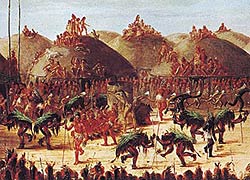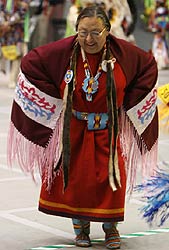
For centuries native peoples have gathered together and engaged in ceremonial and celebratory dance. Men’s Traditional Dance, Women’s Traditional Dance, Grass Dance…all are rooted in those days long ago but like much of American Indian culture, these roots are not simply history. Attend any powwow today and you can see these dances recreated by men, women and children in exhibition and competition as lush illustrations of “living history.”
Men’s Traditional Dance:
Danced with exaggerated movement above the waist to simulate hunting, tracking or fighting but heavy, grounded, flat-footed lower body, this dance originated with members of warrior societies on the Great Plains. Costume includes an eagle feather bustle and hair roach made of porcupine quills. While many tribal gatherings today work to join and unite tribes from across the continent, homogenizing some of the dances to suit all, Men’s Traditional dance remains tribe specific in terms of style and dress.
Women’s Traditional Dance:
This dance is extremely reserved in nature, simply a single or double step done in a circle. Sometimes an up and down movement is done while standing in place. Costume for Women’s Traditional also remains tribal specific, sometimes with elaborate beadwork on long buckskin or trade cloth dresses.
Men’s Grass Dance:
The Grass Dance was first done in the tall prairie of North Dakota at the turn of the 20th century. The costume a shirt with a V-shaped yoke, lots of fringe on the pants and shirts and headdress that might remind you of “antennae.” No bustles are worn. Dancers sway from side to side facing forward around the circle.
Men’s Fancy Dance:
By the middle of the 20th century, tribes gathering together began to see the costuming and innovations in traditional dances becoming more and more elaborate. Beadwork became lavish and the bustles became bigger. Eventually, a bustle at the back of the waist was joined by a second, smaller bustle at the back of the neck and the footwork became more exaggerated and out of this the Fancy Dance was born. Today the Fancy Dance is often the highlight of dance competitions. The colorful visual elements of costume and face paint coupled with quick and spinning footwork and jumps make this dance a favorite of competitors and viewers alike. This dance is intertribal.
 Women’s Fancy/Shawl Dance (pictured):
Women’s Fancy/Shawl Dance (pictured):
It is tradition for a woman to exercise proper etiquette and wear shawl into the dance arena. Women’s Traditional Dance participants wear one, but young women, inspired by and feeling equal to, the male fancy dancers have now created a counterpart for themselves and incorporated the shawl. During this more spirited women’s dance, some wear only a single shawl over street clothes, but a fancy-shawl dancer with full regalia will have a dress, leggings, moccasins, cape and shawl – all matching in decoration. This dance is intertribal.
Women’s Jingle Dress:
This dance is aptly named, because the dress worn by participants does, in fact, jingle. Rows of tin cones adorn the dress in patterns selected by the dancers, which include women of all ages. The tin cones are often made by rolling the heavy metal tops of snuff cans. It is said that a hundred years ago an Ojibwa (Chippewa) holy man had a vision in which four women appeared to him wearing jingle dresses. The dance also bears a resemblance to the Grass Dance, which seemed to originate at the same time. This dance is intertribal.





